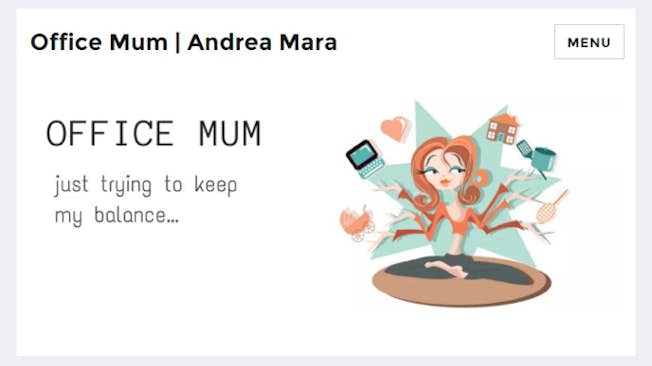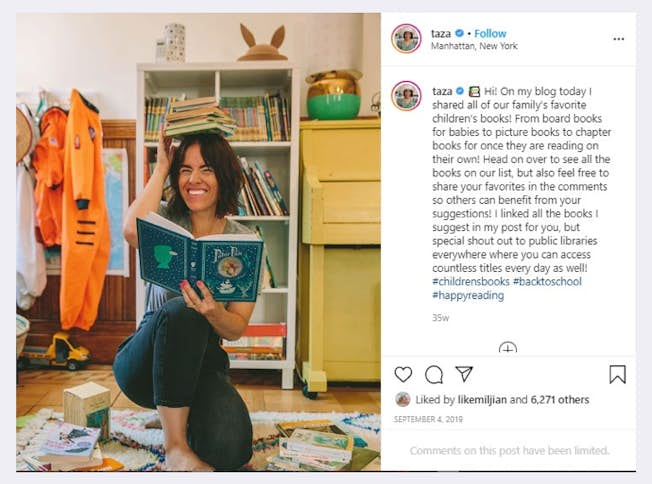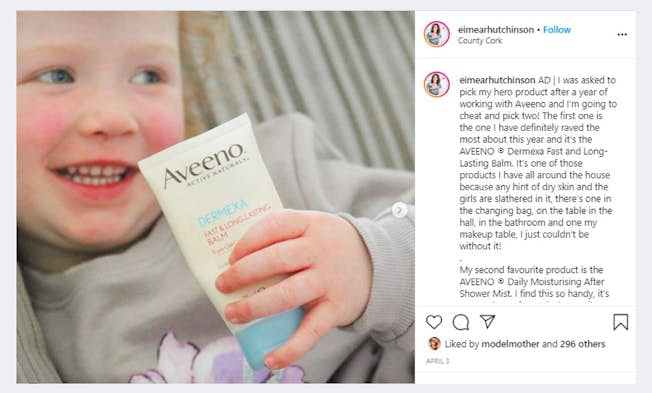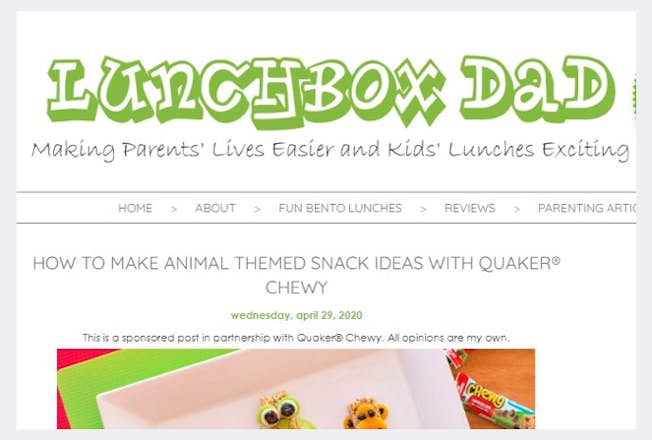This guest post was written by Andrea Mara, author and award-winning blogger at officemum.ie.
“There’s no way to be a perfect mother, and a million ways to be a good one.” Jill Churchill
Seven years ago I told my work colleague a secret: “I’ve started a mom-blog”
She looked bemused. “You’ll have to explain that,” she said, “I’m not really up on all that new tech stuff, like blogs.” The funny thing was that just a week earlier, I’d read an article that proclaimed blogging was dead. For me, a fledgling blogger exploring a new (and in my own head, cutting-edge) hobby, this was terrible news. How could blogging be a thing of the past when I’d only just discovered it?
Here we are today, and I’m still blogging, as are millions of others. Parent-blogging is very much alive, and it has evolved in many ways.
So, what exactly is “Mom Blogging”, how has it changed, and how should digital marketers approach it?

Who is the Mom Blogger?
If this was an FBI profile from TV show Mindhunter, the Mom Blogger would be described like one in a stock photo – you know the one; she’s baking cookies with her smiling children in her pristine kitchen, and nobody is yelling at anyone to stop spilling flour on the dog. The reality, of course, is very different, because for a start, nobody wants to spend all day reading about mothers who are doing everything perfectly. Immaculate kitchens and immaculate children are all very well for a bit of aspirational scrolling but not if they make readers feel inadequate about their own lives. So, fortunately for readers, there are many, many different types of mom bloggers, often with a big helping of messy kitchens and warts-an’-all honesty.
Mom bloggers don’t all come from the same starting point:
Some women have children and decide to write about the day-to-day chaos as a form of therapy. For them, it begins as nothing more than a hobby, a place to let off steam, or a way of connecting with other mothers.
- Some women have platforms before they have children, and morph into mom bloggers when they have kids.
- Some are political, lifestyle, photography, beauty, or sports bloggers, who also happen to have kids, and whose blog posts are written through the filter of motherhood.
- And more recently, we see many setting out to be professional bloggers; actively building followers and opportunities from the get-go.
- Some are not mothers at all; they’re fathers – dad blogs have been around for a long time, although in much smaller volumes than mom bloggers.
Who is reading the Mom Blog, and why?
The short answer: parents and prospective parents. They land on blogs when they google unfamiliar terms like “how to try baby led weaning” or “which sling is best” or “I’m hiding in the bathroom again because they won’t stop bickering”.
Some read the post they find, take the information they need, and will never be able to tell you whose blog they were on. (“Mama Something?”) Others will value or be entertained by the content they read and will return for more. And that is the holy grail for any blogger, (not just a Mom blogger) – the returning reader. Not necessarily because we’re trying to sell something, but because writers need readers.

This, too, sums up the “why” of the question – parents want useful information, or they want to be entertained – especially if the blogger is making an even bigger mess of parenting than they are. And happily, information and entertainment are not mutually exclusive. Two key elements are authenticity and relatability: readers want to nod along with the blog post thinking, “Wow, so I’m really not the only one hiding in the bathroom.” If readers can identify with the blogger, they’ll come back for more.
Parents can find countless articles and books on how to raise kids, but none of this compares to building what feels like a connection or a relationship with a real person – the mom blogger. And in many cases, it is in fact a relationship, because readers comment, and (good) bloggers reply. Once a relationship is established, the reader comes to believe that the blogger can give them truly helpful tips and insights they can use and share.
That’s all very well but where does digital marketing come into it?
If you have consistently high-quality, authentic, relatable content, with a good social media following, you have a hotbed for marketing opportunities – this is true of any kind of blog. But where the mom-blog stands out is trust. If a reader finds a parent blog with trustworthy tips on raising kids and all that’s involved in modern parenting, and then continues to follow that blogger, an inherent trust is built.
Of course, if there are too many sponsored posts, or links to products that don’t seem a credible fit, that trust can be broken. Savvy bloggers are aware of this and provide a good mix of content, weighted towards non-sponsored posts.
What does mom-blog digital marketing look like?
Marketing on parent blogs takes many forms, and is not limited to professional (i.e. money-earning) blogs. In general, all forms of in-blog or in-post marketing should be flagged with hashtags such as #ad or #sponsored. Regulations can vary by country, but there is informal self-regulation within the blogging community that goes over and above regulatory requirements: the rule of thumb is to err on the side of disclosure if in doubt. Here’s a guide to the FTC’s guidelines.
1. Products for review
When I was starting out as a blogger seven years ago, I had no idea that anyone would be interested in having me do reviews or write paid content. Then a small business owner – a woman who made teething jewellery – got in touch to ask if she could send me some of her products to try. In return, I was to write an honest review. Realistically, if I hadn’t liked the products, I wouldn’t have written anything at all. Happily, I did like them, and wrote my first-ever product review. The business owner shared it on her social media, bringing extra followers to me, and I did the same for her. It was an easy win-win.
Today, the social media side of blogging, particularly Instagram, is a lot bigger than it was before and when it’s done well, it can generate really good engagement without putting readers off – despite the fact that the audience is fully aware that what they’re looking at is an ad. See for example The Two Darlings below promoting Aveeno products: it’s hashtagged as an #ad at the start of the Instagram post, but this doesn’t deter readers who are happy to share their positive experiences and questions about the products.

Traditional-style blog posts are still used too – when I’m asked to review products, most brands are still looking for blog posts in addition to social media, suggesting that blogging is definitely not dead.
While some brands will email bloggers to formally ask for and arrange a review, others send products without prior agreement, as part of a media drop. This can happen if the blogger is on a PR agency list. With unsolicited media drops, it’s usual to share a photo on social media but there is no obligation to do so, or to review the product. Sometimes bloggers are sent products that just don’t fit the blogger-brand at all and with experience comes the understanding that it’s fine to ignore these. (A really good gift can make quite an impact – I still think fondly of a luxury chocolate hamper I was sent two years ago, and still make an effort to mention the brand when I can.)
2. Sponsored content
For a sponsored blog post, the blogger receives a payment for writing about a particular product or service. There are endless offers of sponsored post opportunities, but parent bloggers know there’s no quicker way to lose readers than to start writing about car tyres or fishing tackle on a blog that normally deals with baby naps or starting school.
In recent years, while blog posts are still key, there’s been a shift towards other forms of sponsored content, with brands paying to feature in Instagram photos, YouTube videos, Facebook posts, Instagram Stories, and newsletters. (Sponsored content must be flagged with a hashtag such as #ad or #sponsored.)
3. Ambassador programs
An ambassador program is where a blogger is linked with a brand for more than just one photo or post. This may mean the blogger is being paid, or simply receiving free products on an ongoing basis. As above, bloggers should disclose if they are being paid.
4. Affiliate links
This is where a blogger earns a commission when readers click through to particular brands and make purchases, via the blogger’s social media or website. Again, this should always be disclosed.
5. Giveaways
One of the easiest ways for parent bloggers and brands to collaborate is with a giveaway. Over seven years of doing giveaways on social media, I’ve found that the most successful competitions are not necessarily the ones with the highest value prize, but the easiest entry criteria. A good photo and a “comment to enter” can have excellent reach on social media.
How has Mom-Blogging Evolved?
In the past, most bloggers began writing as a hobby. I started primarily to let off steam and to flex a dormant writing muscle. I had no idea that blogging could also involve opportunities for payment or product reviews. Today, some bloggers start for the same reason, but others are already aware of the paid opportunities and set out from the start to become professional bloggers.
We have seen the rise of the Instagram Influencer, like Love, Taza, Cupcakes and Cashmere, Hurrah for Gin, The Unmumsy Mum, and Father of Daughters all with followers in the hundreds of thousands. Instagram, launched in 2010, is the “picture paints a thousand words” solution for the busy mom blogger who doesn’t have time to write an 800-word post and the busy reader who doesn’t have time to read it. It’s the perfect spot to showcase a completed DIY project or freshly-baked sourdough bread – or the product she’s being paid to promote.
And because readers don’t want to see constant perfection, there’s been a trend towards confessional “I’m struggling too” type posts on Instagram in recent years as examined in this New Yorker piece. This trend serves to cement relatability and trust between blogger and reader.
The key elements of a successful mom blog haven’t changed though – it’s still about authenticity, relatability, and trust. A parenting blog with too many paid posts or contrived content striving to sell car tyres or insurance products to its readers will struggle to survive. A good mix of authentic content with a scattering of relevant sponsored posts can work really well. There are no rules about how often a blogger should post, but two or three social media posts a week is good, with website posts less frequently – perhaps once a month, and some Instagrammers don’t have websites at all.

Why Partner with a Mom Blog
It’s basically like word of mouth on steroids, said Danica Kombol, the president and founder of Everywhere Agency, which works with brands to partner them with influencers.
That sums it up in a nutshell – the quickest way to have thousands of parents see your product is to send it to a successful parent blogger. Mom blogs are of interest to brands because they have an audience eager for content (the helpful tips and entertainment point mentioned above) and even more importantly, an audience who trusts their judgement. If you’re trying to market baby products, kid-friendly snack foods, clothing, skincare products, toys, or family-friendly day-trip destinations; a quick google will throw up names of popular bloggers, and a browse through their social media should tell you which bloggers are a fit for your brand.
The next step is to contact the blogger by email or social media message to ask if they’d like to try your product or service.
Something mom bloggers and their readers have in common is of course, parenthood, and parent bloggers know what parents want to read. I am a mom blogger, but first, I am a mom.
The Secrets of Motherhood
As new parents know, there is nothing more precious than a newborn baby, and there’s nothing more terrifying than the sense that we’re getting it all wrong. When we find a blogger who can tell us it’s okay, that we’re okay, that struggling is normal, and, oh by the way, here’s a foolproof way to potty train your child, we might stay to buy the moisturiser or the food mixer she’s promoting too.
Of course, as babies turn into tweens and teens, blogging about parenting issues becomes less appealing or impossible – what happens then?
Some bloggers stop writing altogether, while others move to writing about a wider variety of topics – politics, lifestyle, the environment, books – or simply posting updates on day-to-day life, which is of course how traditional blogging began. But this doesn’t mean the end of mom blogging – there are countless new mothers stepping into the breach, sharing their thoughts and photos online.
Despite what I read seven years ago, blogging is definitely not over – it’s alive and thriving, and open for business.
Related
Upgrade to Power Membership to continue
your access to thousands of articles, toolkits, podcasts, lessons and much much more.
Become a Power Member- Login
- View Courses
- - - -
- Courses
- Resources
- - - -
- My Account
- Change Password
- Logout





